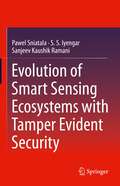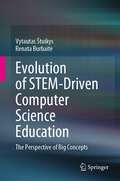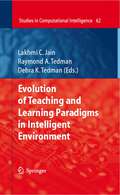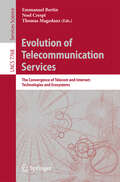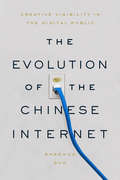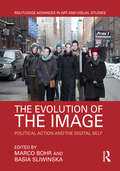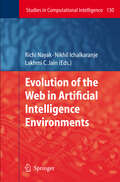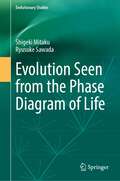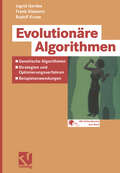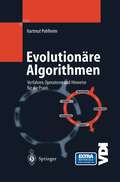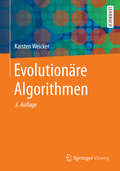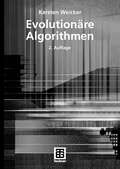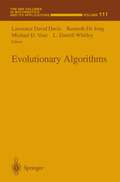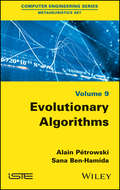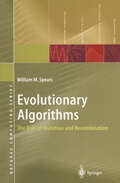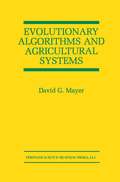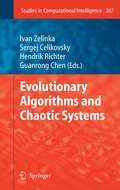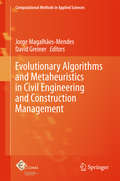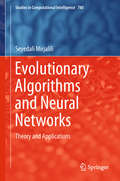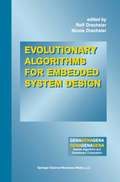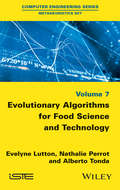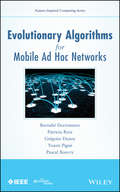- Table View
- List View
Evolution of Smart Sensing Ecosystems with Tamper Evident Security
by Pawel Sniatala S.S. Iyengar Sanjeev Kaushik RamaniThis book presents an overview on security and privacy issues in dynamic sensor networks and Internet of Things (IoT) networks and provides a novel tamper evident technique to counter and defend against these security related issues. The mission of this book is to explain the evolution of techniques and strategies in securing information transfer and storage thus facilitating a digital transition towards the modern tamper evident systems. The goal is also to aid business organizations that are dependent on the analysis of the large volumes of generated data in securing and addressing the associated growing threat of attackers relentlessly waging attacks and the challenges in protecting the confidentiality, integrity and provenance of data. The book also provides a comprehensive insight into the secure communication techniques and tools that have evolved and the impact they have had in supporting and flourishing the business through the cyber era. This book also includes chapters that discuss the most primitive encryption schemes to the most recent use of homomorphism in ensuring the privacy of the data thus leveraging greater use of new technologies like cloud computing and others.
Evolution of STEM-Driven Computer Science Education: The Perspective of Big Concepts
by Vytautas Štuikys Renata BurbaitėThe book discusses the evolution of STEM-driven Computer Science (CS) Education based on three categories of Big Concepts, Smart Education (Pedagogy), Technology (tools and adequate processes) and Content that relates to IoT, Data Science and AI. For developing, designing, testing, delivering and assessing learning outcomes for K-12 students (9-12 classes), the multi-dimensional modelling methodology is at the centre. The methodology covers conceptual and feature-based modelling, prototyping, and virtual and physical modelling at the implementation and usage level. Chapters contain case studies to assist understanding and learning. The book contains multiple methodological and scientific innovations including models, frameworks and approaches to drive STEM-driven CS education evolution.Educational strategists, educators, and researchers will find valuable material in this book to help them improve STEM-driven CS education strategies, curriculum development, and new ideas for research.
Evolution of Teaching and Learning Paradigms in Intelligent Environment (Studies in Computational Intelligence #62)
by Raymond A. Tedman Debra K. TedmanThis book is a fascinating window on the evolution of teaching and learning paradigms in intelligent environments. It presents the latest ideas coming out of educational computing research. The three Australian authors include a number of chapters on issues of real relevance to today’s teaching practice, including an introduction to the evolution of teaching and learning paradigms; why designers cannot be agnostic about pedagogy, and the influence of constructivist thinking in design of e-learning for HE.
Evolution of Telecommunication Services: The Convergence of Telecom and Internet: Technologies and Ecosystems (Lecture Notes in Computer Science #7768)
by Emmanuel Bertin Noël Crespi Thomas MagedanzIn the telecom world, services have usually been conceived with a specific mindset. This mindset has defined the traditional characteristics of these services; services distinguished by their linkage with the access network, tight control over service use (e.g., authentication, billing), lack of deep personalization capabilities (mass services only) and reliance on standardization to achieve end-to-end interoperability between all the actors of the value chain (e.g., operators, platform manufacturers, device manufactures). This book offers insights into this complex but exciting world of telecommunications characterized by constant evolution, and approaches it from technology as well as business perspectives. The book is appropriately structured in three parts: (a) an overview of the state-of-the-art in fixed/mobile NGN and standardization activities; (b) an analysis of the competitive landscape between operators, device manufactures and OTT providers, emphasizing why network operators are challenged on their home turf; and (c) opportunities for business modeling and innovative telecom service offers.
The Evolution of the Chinese Internet: Creative Visibility in the Digital Public
by Shaohua GuoDespite widespread consensus that China's digital revolution was sure to bring about massive democratic reforms, such changes have not come to pass. While scholars and policy makers alternate between predicting change and disparaging a stubbornly authoritarian regime, in this book Shaohua Guo demonstrates how this dichotomy misses the far more complex reality. The Evolution of the Chinese Internet traces the emergence and maturation of one of the most creative digital cultures in the world through four major technological platforms: the bulletin board system, the blog, the microblog, and WeChat. Guo transcends typical binaries of freedom and control, to argue that Chinese Internet culture displays a uniquely sophisticated interplay between multiple extremes, and that its vibrancy is dependent on these complex negotiations. In contrast to the flourishing of research findings on what is made invisible online, this book examines the driving mechanisms that grant visibility to particular kinds of user-generated content. Offering a systematic account of how and why an ingenious Internet culture has been able to thrive, Guo highlights the pivotal roles that media institutions, technological platforms, and creative practices of Chinese netizens have played in shaping culture on- and offline.
The Evolution of the Image: Political Action and the Digital Self (Routledge Advances in Art and Visual Studies)
by Marco Bohr Basia SliwinskaThis volume addresses the evolution of the visual in digital communities, offering a multidisciplinary discussion of the ways in which images are circulated in digital communities, the meanings that are attached to them and the implications they have for notions of identity, memory, gender, cultural belonging and political action. Contributors focus on the political efficacy of the image in digital communities, as well as the representation of the digital self in order to offer a fresh perspective on the role of digital images in the creation and promotion of new forms of resistance, agency and identity within visual cultures.
The Evolution of the Image: Political Action and the Digital Self (Routledge Advances in Art and Visual Studies)
by Marco Bohr Basia SliwinskaThis volume addresses the evolution of the visual in digital communities, offering a multidisciplinary discussion of the ways in which images are circulated in digital communities, the meanings that are attached to them and the implications they have for notions of identity, memory, gender, cultural belonging and political action. Contributors focus on the political efficacy of the image in digital communities, as well as the representation of the digital self in order to offer a fresh perspective on the role of digital images in the creation and promotion of new forms of resistance, agency and identity within visual cultures.
Evolution of the Web in Artificial Intelligence Environments (Studies in Computational Intelligence #130)
by Richi Nayak N. IchalkaranjeThe Web has revolutionized the way we seek information on all aspects of education, entertainment, business, health and so on. The Web has evolved into a publishing medium, global electronic market and increasingly, a platform for conducting electronic commerce. A part of this success can be attributed to the tremendous advances made in the Artificial Intelligence field. The popularity of the Web has opened many opportunities to develop smart Web-based systems using artificial intelligence techniques. There exist numerous Web technology and applications that can benefit with the application of artificial intelligence techniques. It is not possible to cover them all in one book with a required degree of quality, depth and width. We present this book to discuss some important Web developments by using artificial intelligence techniques in the areas of Web personalisation, semantic Web and Web services. The primary readers of this book are undergraduate/postgraduate students, researchers and practitioners in information technology and computer science related areas. The success of this book is largely due to the collective efforts of a great team consisting of authors and reviewers. We are grateful to them for their vision and wonderful support. The final quality of selected papers reflects their efforts. Finally we would like to thank the Queensland University of Technology, Brisbane Australia and University of South Australia, Adelaide Australia for providing us the resources and time to undertake this task. We extend our sincere thanks to Scientific Publishing Services Pvt. Ltd., for the editorial support.
Evolution Seen from the Phase Diagram of Life (Evolutionary Studies)
by Shigeki Mitaku Ryusuke SawadaThis book aims to understand biological evolution through a physical approach, focusing on the macroscopic aspects of the biological genome. Readers will discover the connection between genomic information and the harmony of biological systems, a relationship that remains elusive to many researchers in biological sciences.The most common approach to understanding living organisms with physics is to begin with a single molecule of an organism. In contrast to this bottom-up approach, building from each molecule to the whole, this book takes a coarse-grained approach at the amino acid level to physically understand the macroscopic aspects of the organism. The book presents a system developed by the authors to predict membrane proteins with high accuracy using only physical parameters. Another distinctive perspective of this book is that it proposes the idea of a physical mechanism, other than natural selection, that orchestrates the emergence of order from random processes.The study of macroscopic aspects of living organisms based on this concept has parallels with thermostatistical mechanics for states of matter. Just as random processes create order in matter, there are physical random processes that form order in living organisms. This analogy is the central theme of the book.Using terms and analogies familiar to physicists, the book bridges the gap between biological and physical sciences. The book focuses on simple principles and is aimed primarily at researchers. While the content of this book is at the boundary area of biophysics, soft matter physics and bioinformatics, it will also be of interest to researchers and graduate students working on any biological topics.
Evolutionäre Algorithmen: Genetische Algorithmen — Strategien und Optimierungsverfahren — Beispielanwendungen (Computational Intelligence)
by Ingrid Gerdes Frank Klawonn Rudolf KruseEvolutionäre Algorithmen bilden eine Klasse sehr universeller Werkzeuge zur Lösung von Optimierungsproblemen. Mit diesem Buch lernen Sie alles Wesentliche über dieses spannende Gebiet - ausgehend von den Grundlagen bis hin in die Anwendung. Es geht um Techniken wie genetische Algorithmen, Evolutionsstrategien und genetische Programmierung. Gewinnen Sie ein klares Verständnis der zugrunde liegenden strategischen Arbeitsweise der einzelnen Algorithmen. Dies schafft die Voraussetzung für den effizienten Einsatz der Optimierungsverfahren in der Praxis.
Evolutionäre Algorithmen: Verfahren, Operatoren und Hinweise für die Praxis (VDI-Buch)
by Hartmut PohlheimEvolutionäre Algorithmen als Optimierungsverfahren bieten vielfältige Anwendungsmöglichkeiten für ingenieurtechnische Lösungen industrieller Aufgaben. Dieses Buch dient in seiner Aufbereitung als praxisnahes Nachschlagewerk. In anwendungsorientierter Art und Weise werden, von einer einfachen Struktur Evolutionärer Algorithmen ausgehend, grundlegende Bestandteile, Verfahren, Operatoren und Erweiterungen beschrieben und in ihren Anwendungsmöglich- keiten analysiert. Durch die ausführliche Darstellung mehrerer ausgewählter Praxisbeispiele wird ein Einblick in die Anwendung Evolutionärer Algorithmen gegeben. Für den Einsatz in der Praxis ist dies von unschätzbarem Wert. Die dem Buch beiliegende Toolbox für Matlab bietet einen guten Einstieg in die Arbeit mit Evolutionären Algorithmen und kann sofort für die Lösung eigener Praxisprobleme genutzt werden. Der Benutzer erhält neben dem notwendigen Grundwissen ein wertvolles Arbeitsmittel an die Hand.
Evolutionäre Algorithmen
by Karsten WeickerFür die Lösung von Optimierungsproblemen mit evolutionären Algorithmen stattet dieses Buch seine Leser sowohl mit den gängigen Standardalgorithmen als auch mit den Arbeitsprinzipien, Vorgehensweisen und speziellen Techniken aus, mit denen evolutionäre Algorithmen für spezielle Probleme angepasst werden. Dabei zeichnen das Buch vor allem die hohe Anzahl an Beispielen, die anschauliche Darstellung der Grundlagen sowie vier ausführliche Fallstudien aus. Für die Anwendung evolutionärer Algorithmen in Industrie, Wirtschaft und Forschung sind die vorgestellten Ansätze zur Berücksichtigung von Randbedingungen, mehrerer sich widersprechender Zielfunktionen und verrauschte oder zeitabhängige Aspekte von großer Bedeutung. Evolutionäre Algorithmen sind ein vergleichsweise junges Optimierungsverfahren, welches das Wechselspiel zwischen Variation und Selektion der natürlichen Evolution imitiert.
Evolutionäre Algorithmen (XLeitfäden der Informatik)
by Karsten WeickerEvolutionäre Algorithmen sind relativ neue Methoden zur Lösung von Optimierungsproblemen in Industrie, Wirtschaft und Forschung. Inspiriert durch die biologische Evolution imitieren sie das Wechselspiel zwischen Variation von Individuen und Selektion. In diesem Lehrbuch wird neben der Darstellung der Standardalgorithmen vor allem das gängige Verständnis für die Arbeitsweise und die zu Grunde liegenden Prinzipien vermittelt. Darüber hinaus werden spezielle Anforderungen aus der Praxis, wie z. B. die Beachtung von Randbedingungen, Mehrzieloptimierung und verrauschte oder zeitabhängige Probleme, diskutiert. In der nun vorliegenden zweiten Auflage wurde insbesondere die praktische Anwendung anhand von Fallbeispielen aus verschiedenen Themenbereichen stärker berücksichtigt.
Evolutionary Algorithms (The IMA Volumes in Mathematics and its Applications #111)
by Lawrence D. Davis Kenneth De Jong Michael D. Vose L. Darrell WhitleyThis IMA Volume in Mathematics and its Applications EVOLUTIONARY ALGORITHMS is based on the proceedings of a workshop that was an integral part of the 1996-97 IMA program on "MATHEMATICS IN HIGH-PERFORMANCE COMPUTING." I thank Lawrence David Davis (Tica Associates), Kenneth De Jong (Computer Science, George Mason University), Michael D. Vose (Computer Science, The University of Tennessee), and L. Darrell Whitley (Computer Science, Colorado State University) for their excellent work in organizing the workshop and for editing the proceedings. Further appreciation is ex tended to Donald G. Truhlar (Chemistry and Supercomputing Institute, University of Minnesota) who was also one of the workshop organizers. In addition, I also take this opportunity to thank the National Science Foundation (NSF), Minnesota Supercomputing Institute (MSI), and the Army Research Office (ARO), whose financial support made the workshop possible. Willard Miller, Jr., Professor and Director v PREFACE The IMA Workshop on Evolutionary Algorithms brought together many of the top researchers working in the area of Evolutionary Com putation for a week of intensive interaction. The field of Evolutionary Computation has developed significantly over the past 30 years and today consists a variety of subfields such as genetic algorithms, evolution strate gies, evolutionary programming, and genetic programming, each with their own algorithmic perspectives and goals.
Evolutionary Algorithms: An Overview
by Alain Petrowski Sana Ben-HamidaEvolutionary algorithms are bio-inspired algorithms based on Darwin’s theory of evolution. They are expected to provide non-optimal but good quality solutions to problems whose resolution is impracticable by exact methods. In six chapters, this book presents the essential knowledge required to efficiently implement evolutionary algorithms. Chapter 1 describes a generic evolutionary algorithm as well as the basic operators that compose it. Chapter 2 is devoted to the solving of continuous optimization problems, without constraint. Three leading approaches are described and compared on a set of test functions. Chapter 3 considers continuous optimization problems with constraints. Various approaches suitable for evolutionary methods are presented. Chapter 4 is related to combinatorial optimization. It provides a catalog of variation operators to deal with order-based problems. Chapter 5 introduces the basic notions required to understand the issue of multi-objective optimization and a variety of approaches for its application. Finally, Chapter 6 describes different approaches of genetic programming able to evolve computer programs in the context of machine learning.
Evolutionary Algorithms: An Overview
by Alain Petrowski Sana Ben-HamidaEvolutionary algorithms are bio-inspired algorithms based on Darwin’s theory of evolution. They are expected to provide non-optimal but good quality solutions to problems whose resolution is impracticable by exact methods. In six chapters, this book presents the essential knowledge required to efficiently implement evolutionary algorithms. Chapter 1 describes a generic evolutionary algorithm as well as the basic operators that compose it. Chapter 2 is devoted to the solving of continuous optimization problems, without constraint. Three leading approaches are described and compared on a set of test functions. Chapter 3 considers continuous optimization problems with constraints. Various approaches suitable for evolutionary methods are presented. Chapter 4 is related to combinatorial optimization. It provides a catalog of variation operators to deal with order-based problems. Chapter 5 introduces the basic notions required to understand the issue of multi-objective optimization and a variety of approaches for its application. Finally, Chapter 6 describes different approaches of genetic programming able to evolve computer programs in the context of machine learning.
Evolutionary Algorithms: The Role of Mutation and Recombination (Natural Computing Series)
by William M. SpearsDespite decades of work in evolutionary algorithms, there remains an uncertainty as to the relative benefits and detriments of using recombination or mutation. This book provides a characterization of the roles that recombination and mutation play in evolutionary algorithms. It integrates important prior work and introduces new theoretical techniques for studying evolutionary algorithms. Consequences of the theory are explored and a novel method for comparing search and optimization algorithms is introduced. The focus allows the book to bridge multiple communities, including evolutionary biologists and population geneticists.
Evolutionary Algorithms and Agricultural Systems (The Springer International Series in Engineering and Computer Science #647)
by David G. MayerEvolutionary Algorithms and Agricultural Systems deals with the practical application of evolutionary algorithms to the study and management of agricultural systems. The rationale of systems research methodology is introduced, and examples listed of real-world applications. It is the integration of these agricultural systems models with optimization techniques, primarily genetic algorithms, which forms the focus of this book. The advantages are outlined, with examples of agricultural models ranging from national and industry-wide studies down to the within-farm scale. The potential problems of this approach are also discussed, along with practical methods of resolving these problems. Agricultural applications using alternate optimization techniques (gradient and direct-search methods, simulated annealing and quenching, and the tabu search strategy) are also listed and discussed. The particular problems and methodologies of these algorithms, including advantageous features that may benefit a hybrid approach or be usefully incorporated into evolutionary algorithms, are outlined. From consideration of this and the published examples, it is concluded that evolutionary algorithms are the superior method for the practical optimization of models of agricultural and natural systems. General recommendations on robust options and parameter settings for evolutionary algorithms are given for use in future studies. Evolutionary Algorithms and Agricultural Systems will prove useful to practitioners and researchers applying these methods to the optimization of agricultural or natural systems, and would also be suited as a text for systems management, applied modeling, or operations research.
Evolutionary Algorithms and Chaotic Systems (Studies in Computational Intelligence #267)
by Hendrik Richter Guanrong Chen Ivan Zelinka Sergej CelikovskýEvolutionary Algorithms and Metaheuristics in Civil Engineering and Construction Management (Computational Methods in Applied Sciences #39)
by Jorge Magalhães-Mendes David GreinerThis book focuses on civil and structural engineering and construction management applications. The contributions constitute modified, extended and improved versions of research presented at the minisymposium organized by the editors at the ECCOMAS conference on this topic in Barcelona 2014.
Evolutionary Algorithms and Neural Networks: Theory and Applications (Studies in Computational Intelligence #780)
by Seyedali MirjaliliThis book introduces readers to the fundamentals of artificial neural networks, with a special emphasis on evolutionary algorithms. At first, the book offers a literature review of several well-regarded evolutionary algorithms, including particle swarm and ant colony optimization, genetic algorithms and biogeography-based optimization. It then proposes evolutionary version of several types of neural networks such as feed forward neural networks, radial basis function networks, as well as recurrent neural networks and multi-later perceptron. Most of the challenges that have to be addressed when training artificial neural networks using evolutionary algorithms are discussed in detail. The book also demonstrates the application of the proposed algorithms for several purposes such as classification, clustering, approximation, and prediction problems. It provides a tutorial on how to design, adapt, and evaluate artificial neural networks as well, and includes source codes for most of the proposed techniques as supplementary materials.
Evolutionary Algorithms for Embedded System Design (Genetic Algorithms and Evolutionary Computation #10)
by Rolf Drechsler Nicole DrechslerEvolutionary Algorithms for Embedded System Design describes how Evolutionary Algorithm (EA) concepts can be applied to circuit and system design - an area where time-to-market demands are critical. EAs create an interesting alternative to other approaches since they can be scaled with the problem size and can be easily run on parallel computer systems. This book presents several successful EA techniques and shows how they can be applied at different levels of the design process. Starting on a high-level abstraction, where software components are dominant, several optimization steps are demonstrated, including DSP code optimization and test generation. Throughout the book, EAs are tested on real-world applications and on large problem instances. For each application the main criteria for the successful application in the corresponding domain are discussed. In addition, contributions from leading international researchers provide the reader with a variety of perspectives, including a special focus on the combination of EAs with problem specific heuristics. Evolutionary Algorithms for Embedded System Design is an excellent reference for both practitioners working in the area of circuit and system design and for researchers in the field of evolutionary concepts.
Evolutionary Algorithms for Food Science and Technology
by Evelyne Lutton Nathalie Perrot Alberto TondaResearchers and practitioners in food science and technology routinely face several challenges, related to sparseness and heterogeneity of data, as well as to the uncertainty in the measurements and the introduction of expert knowledge in the models. Evolutionary algorithms (EAs), stochastic optimization techniques loosely inspired by natural selection, can be effectively used to tackle these issues. In this book, we present a selection of case studies where EAs are adopted in real-world food applications, ranging from model learning to sensitivity analysis.
Evolutionary Algorithms for Food Science and Technology
by Evelyne Lutton Nathalie Perrot Alberto TondaResearchers and practitioners in food science and technology routinely face several challenges, related to sparseness and heterogeneity of data, as well as to the uncertainty in the measurements and the introduction of expert knowledge in the models. Evolutionary algorithms (EAs), stochastic optimization techniques loosely inspired by natural selection, can be effectively used to tackle these issues. In this book, we present a selection of case studies where EAs are adopted in real-world food applications, ranging from model learning to sensitivity analysis.
Evolutionary Algorithms for Mobile Ad Hoc Networks (Nature-Inspired Computing Series)
by Bernabé Dorronsoro Patricia Ruiz Grégoire Danoy Yoann Pigné Pascal BouvryDescribes how evolutionary algorithms (EAs) can be used to identify, model, and minimize day-to-day problems that arise for researchers in optimization and mobile networking Mobile ad hoc networks (MANETs), vehicular networks (VANETs), sensor networks (SNs), and hybrid networks—each of these require a designer’s keen sense and knowledge of evolutionary algorithms in order to help with the common issues that plague professionals involved in optimization and mobile networking. This book introduces readers to both mobile ad hoc networks and evolutionary algorithms, presenting basic concepts as well as detailed descriptions of each. It demonstrates how metaheuristics and evolutionary algorithms (EAs) can be used to help provide low-cost operations in the optimization process—allowing designers to put some “intelligence” or sophistication into the design. It also offers efficient and accurate information on dissemination algorithms, topology management, and mobility models to address challenges in the field. Evolutionary Algorithms for Mobile Ad Hoc Networks: Instructs on how to identify, model, and optimize solutions to problems that arise in daily research Presents complete and up-to-date surveys on topics like network and mobility simulators Provides sample problems along with solutions/descriptions used to solve each, with performance comparisons Covers current, relevant issues in mobile networks, like energy use, broadcasting performance, device mobility, and more Evolutionary Algorithms for Mobile Ad Hoc Networks is an ideal book for researchers and students involved in mobile networks, optimization, advanced search techniques, and multi-objective optimization.
